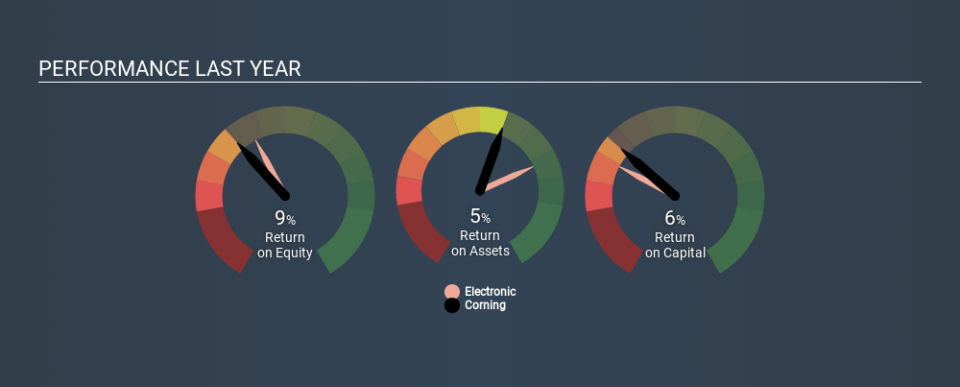Why We’re Not Keen On Corning Incorporated’s (NYSE:GLW) 6.1% Return On Capital

Today we are going to look at Corning Incorporated (NYSE:GLW) to see whether it might be an attractive investment prospect. In particular, we'll consider its Return On Capital Employed (ROCE), as that can give us insight into how profitably the company is able to employ capital in its business.
First, we'll go over how we calculate ROCE. Next, we'll compare it to others in its industry. Then we'll determine how its current liabilities are affecting its ROCE.
Understanding Return On Capital Employed (ROCE)
ROCE measures the amount of pre-tax profits a company can generate from the capital employed in its business. All else being equal, a better business will have a higher ROCE. In brief, it is a useful tool, but it is not without drawbacks. Renowned investment researcher Michael Mauboussin has suggested that a high ROCE can indicate that 'one dollar invested in the company generates value of more than one dollar'.
So, How Do We Calculate ROCE?
The formula for calculating the return on capital employed is:
Return on Capital Employed = Earnings Before Interest and Tax (EBIT) ÷ (Total Assets - Current Liabilities)
Or for Corning:
0.061 = US$1.5b ÷ (US$27b - US$3.6b) (Based on the trailing twelve months to September 2019.)
So, Corning has an ROCE of 6.1%.
See our latest analysis for Corning
Is Corning's ROCE Good?
ROCE is commonly used for comparing the performance of similar businesses. We can see Corning's ROCE is meaningfully below the Electronic industry average of 12%. This performance could be negative if sustained, as it suggests the business may underperform its industry. Separate from how Corning stacks up against its industry, its ROCE in absolute terms is mediocre; relative to the returns on government bonds. Investors may wish to consider higher-performing investments.
We can see that, Corning currently has an ROCE of 6.1% compared to its ROCE 3 years ago, which was 4.5%. This makes us think about whether the company has been reinvesting shrewdly. You can click on the image below to see (in greater detail) how Corning's past growth compares to other companies.
When considering this metric, keep in mind that it is backwards looking, and not necessarily predictive. ROCE can be deceptive for cyclical businesses, as returns can look incredible in boom times, and terribly low in downturns. ROCE is, after all, simply a snap shot of a single year. What happens in the future is pretty important for investors, so we have prepared a free report on analyst forecasts for Corning.
Do Corning's Current Liabilities Skew Its ROCE?
Current liabilities are short term bills and invoices that need to be paid in 12 months or less. Due to the way the ROCE equation works, having large bills due in the near term can make it look as though a company has less capital employed, and thus a higher ROCE than usual. To check the impact of this, we calculate if a company has high current liabilities relative to its total assets.
Corning has total liabilities of US$3.6b and total assets of US$27b. As a result, its current liabilities are equal to approximately 13% of its total assets. This is a modest level of current liabilities, which would only have a small effect on ROCE.
What We Can Learn From Corning's ROCE
With that in mind, we're not overly impressed with Corning's ROCE, so it may not be the most appealing prospect. Of course, you might also be able to find a better stock than Corning. So you may wish to see this free collection of other companies that have grown earnings strongly.
I will like Corning better if I see some big insider buys. While we wait, check out this free list of growing companies with considerable, recent, insider buying.
If you spot an error that warrants correction, please contact the editor at editorial-team@simplywallst.com. This article by Simply Wall St is general in nature. It does not constitute a recommendation to buy or sell any stock, and does not take account of your objectives, or your financial situation. Simply Wall St has no position in the stocks mentioned.
We aim to bring you long-term focused research analysis driven by fundamental data. Note that our analysis may not factor in the latest price-sensitive company announcements or qualitative material. Thank you for reading.

 Yahoo Finance
Yahoo Finance 
